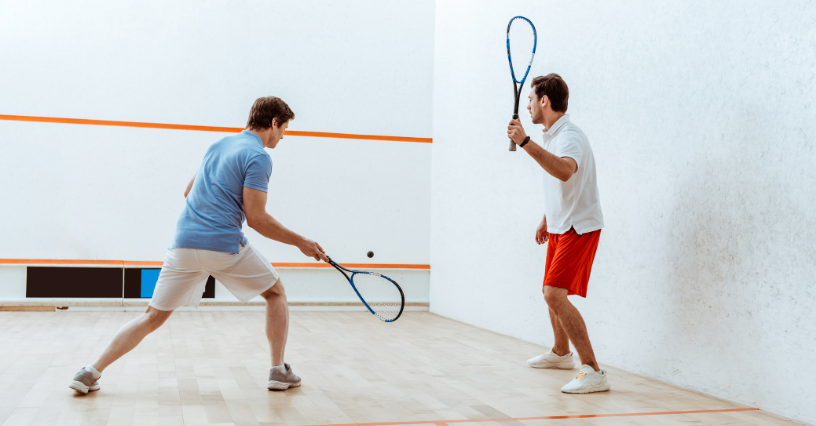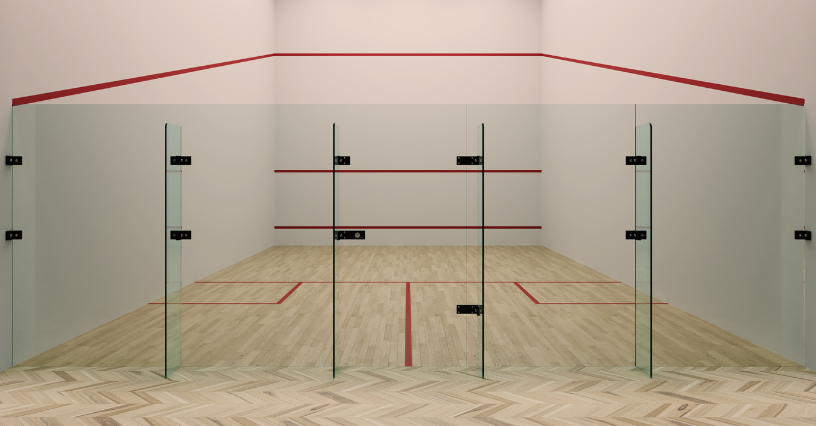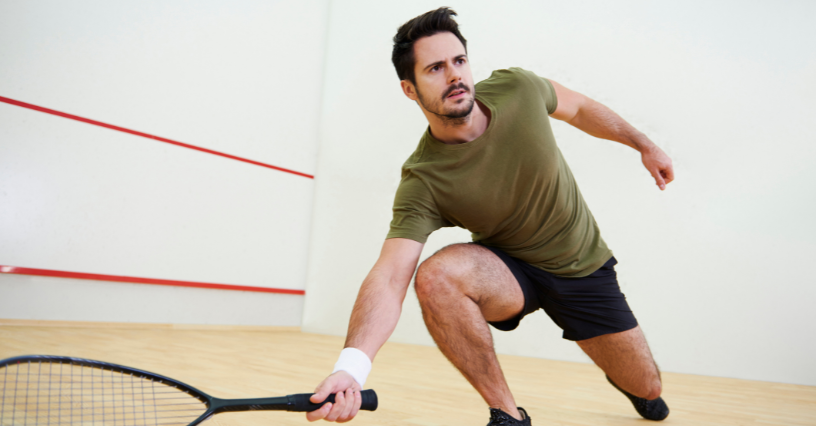Two players with a racket in hand dynamically move around a closed court and try to hit the ball against the front wall so that the opponent does not counterattack – this is the simplest way to describe squash.
Learn the rules of the game, ball throwing techniques and tips that will help you as you begin your squash adventure.
What is pumpkin?
Squash is one of the racquet sports whose history began in the first half of the 19th century in Great Britain and is associated with the Harrow School in England. About. 1830, his students discovered that after being hit with a racket, a perforated rubber ball ricocheted at different angles on contact with the wall, making the game more demanding and varied than tennis or “Racquet ” (a form of entertainment pioneered by the inmates of the “Fleet Prison” in London, which is indicated by the World Squash Federation as the basis of squash).
The name squash comes from the way the punched ball behaves after hitting the wall – it has been ‘squished’.

What is the game of squash all about?
In the simplest terms, squash involves playing on an enclosed court and hitting a dedicated ball against the walls using an oval-shaped racket so that the opponent cannot counterattack . A squash court measuring 975 cm in length, 640 cm in width and 564 cm in height is surrounded by four walls – a front wall, two side walls and a back wall (usually made of glass, containing the entrance door ) participating in the game. The playing field is delimited by special lines that divide the field into several zones (for more information about lines, see later in this article).

Squash is played with a small rubber ball of 24 g and about 4 cm in diameter, which has markings in the form of one or two yellow, blue or red dots. The colored dots indicate the speed of the ball and the height at which it bounces:
- The two yellow dots on the ball indicate that it ricochets slowly and at low speed, which reduces reaction time. It is dedicated to professional and advanced players.
- A yellow dot also distinguishes slow balls that bounce slightly higher than the previous model. Suitable for intermediate and advanced players.
- A red dot on the ball indicates an average performance in terms of speed and bounce height. It will work well for recreational users and during training sessions.
- a blue dot says the ball is fast and bounces high. It’s worth seeking out at the start of your squash adventure.
How is squash played? Technique and style
Developing the correct squash technique and style is a matter of regularity.

There are two hitting techniques in squash:
- Reverse – the body is positioned facing the left wall of the field, with the right foot in front;
- forehand – your body is positioned facing the right wall of the court and your left foot is positioned in front.
What types of shots can be used in squash?
- line/drive – bounce a long ball in a straight line (flying parallel to the side wall);
- volley – throwing the ball out of the air before it hits the floor for the first time;
- A drop shot – also known as a short cut – is a play in which the ball travels towards the side wall after bouncing down over the TIN;
- praise – the ball hits the side wall;
- cross/cross court drive – a long throw of the ball in the opposite half of the court.
The optimal positioning of the squash racket is when the side edge of the handle is between the thumb and forefinger. Maintain a right angle (90 degrees) between the racket and the forearm.
Squash: the most important rules of the game
In order to take full advantage of the benefits of squash (including improved physical condition, better agility and coordination, high calorie burning – up to 100 kcal per hour of play, the possibility of reducing stress levels), it is necessary to know the most important rules of the game. This will make the game efficient, enjoyable and safe for you and your opponent. Two rules apply during the game:
- LET – your opponent can stop play when you prevent them from getting to the ball. The game is then resumed without the loss of a point;
- STROKE – when you position yourself on the court in such a way that you prevent your opponent from putting the ball back when he was already ready to hit it and could have done so. In this situation, the game is stopped and you lose a point.
Heating
This is an essential element that should precede entering the court and starting a practice session or squash match.
By properly preparing the body for exercise, including by: increasing body temperature, increasing oxygen uptake and range of motion of muscles, joints and ligaments, you reduce the risk of injury/illness and increase the efficiency of exercise.
The duration of the warm-up is an individual matter, but it is worth spending at least 10 minutes on it . To begin with, get your heart rate up by doing cardio exercises like jogging or running (on the spot, in different configurations, or on a treadmill), jumping, twisting, jumping, etc. The next stage of the squash warm-up should include the preparation of the parts of the body most involved in the game. Perform shoulder, arm and wrist movement exercises, arm and leg movements, lunges, push-ups, jumps, squats, ankle circles, etc. Then, make sure you get your heart rate up as much as possible by sprinting, jumping, etc. After these 3 parts, get on the court, grab your racket and start warming up by mimicking game plays – alone or with a partner. Warming up the ball is also important here – it will bounce faster and higher.
service

At the start of a practice/sparring/match, service is determined by a toss involving a spin of the racket and the players indicating which way it will land on the court (up or down). The winner indicates the side from which the service will begin.
The service square on the squash court is near the cross line and the side wall. Position yourself so that at least part of one foot is resting on the surface of the service box. Do not touch any line with your foot.
Toss the ball up and racquet it so that it hits the front wall, bounces above the service line but below the out line, and lands on the opposing side.
After you make a good serve, you switch sides of the court until you lose the shift. If you win the set, you serve first in the next game.
Lines
The court surface is divided into two sections, front and back, by the forward line and into three boxes: the front half, the right back quadrant and the left back quadrant, which are defined by the half court line. The two back boxes are still made up of smaller service squares.

In addition, on the squash court we have:
- car lines – the upper red lines on the front and side walls. In the case of the rear wall, cars mark the edge of the window;
- service line – the middle line on the front wall;
- the transverse line – it is on the floor and passes between the side walls;
- exit line – this runs along the top of the front wall, then down the side walls and ends at the back wall;
- the so-called TIN , which is a plate on the front wall indicating the lower car field.
The lines are not included in the field of play, so hitting them is treated as an out, which is equivalent to losing a point.
puncture
During the game, the ball can bounce off any number of walls and in any arrangement, but ultimately it must always hit the front wall before falling to the floor. To win a set, 11 points must be scored. In the event of a 10:10 tie, play continues until one player has a 2-point lead (eg 12:10, 13:11, 14:12, etc.). The match continues until one of the players wins 3 sets (professional tournaments) or 2 sets (sparring, championship matches).

When do you lose points when playing squash?
There are several situations where you can lose points during the game of squash. These are situations where the ball:
- He will double jump off the ground before picking it up;
- will not touch the front wall when hit;
- hits board or under;
- it will hit the grid or the ceiling;
- touches the top line of the car or is above it;
- will do a backflip on the dance floor before crashing into the front wall;
- He will hit you after he jumps off the wall ahead and you were the one who performed the hit;
- fly off the field you are playing on.
In squash, you also lose points due to incorrect service (for example, touching the service line with your foot), so-called hitting, and when you hit the ball twice during a game.



